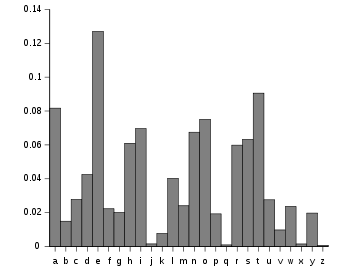The affine cipher is a type of monoalphabetic substitution cipher. It encrypts a text using an affine function (f(x) = ax + b).
-
Firstly, each character of the initial text (message to encrypt) is converted in a number from 0 to 25, corresponding to its position in the Latin alphabet which contains 26 letters --> (a = 0, b = 1 ... z = 25 ).
-
Then, each number obtained is transformed by an affine function (f(x) = ax + b). "x" is representing the number while "a" and "b" are defined during the encryption. "a" and "b" are the keys required to decrypt the final message.
-
If we take all the images and put them in a list, we obtain n numbers corresponding to n characters of the initial text. The next step consists in finding the values of modulo 26 of each number. (Modulo means remainder)
Example : Modulo 4 of 19 is 3 because 15 = 4 * 4 + 3 In the other hand, modulo 26 of 26 is 0 because 26 = 26 * 1 + 0
-
Therefore, we obtain a new list with n element, each between 0 and 25 both included. All these numbers are converted in letters of the Latin Alphabet using the tables below.
-
We finally create the final message by putting all the letters side by side.
Steps 1 and 4 can be done with these tables :
| A | B | C | D | E | F | G | H | I | J | K | L | M |
|---|---|---|---|---|---|---|---|---|---|---|---|---|
| 0 | 1 | 2 | 3 | 4 | 5 | 6 | 7 | 8 | 9 | 10 | 11 | 12 |
| N | O | P | Q | R | S | T | U | V | W | X | Y | Z |
|---|---|---|---|---|---|---|---|---|---|---|---|---|
| 13 | 14 | 15 | 16 | 17 | 18 | 19 | 20 | 21 | 22 | 23 | 24 | 25 |
-
As each letter is encrypted using the same function, trying many possibilities for a or b can be useful to decrypt the message. This is called the bruteforce method.
-
We can also use frequency analysis if the message is long to decrypt the message as the most common letters in english are :
-
Other possibilities include guessing the keys a and b.
-
Knowing a can be helpful to eliminate a lot of solutions.
- Message to encrypt : ATTACK
- Function used : f(x) = 3x + 6
- That means that a = 3 and b = 6
Using the above tables, ATTACK can be written as : 0 19 19 0 2 10 Images of each number :
- f(0) = 6
- f(19) = 63
- f(2) = 12
- f(10) = 36
The new list is : 6 63 63 6 12 36
Using the modulo 26 method, we obtain:
- Mod(6,26) = 6
- Mod(63,26) = 11
- Mod(12,26) = 12
- Mod(36,26) = 10
The final message is 6 11 11 6 12 10 and using the tables again, we convert them in the encrypted message :
GLLGMK
ATTACK is encrypted with the function 3x + 6 and becomes GLLGMK.
- Message to decrypt : GLLGMK
- That means that a = 3 and b = 6
- Hence a-1 = modular multiplicative inverse of a modulo m (m = 26), a-1 = 9
- Function used : f(x) = 9x - 54
Using the above tables, GLLGMK can be written as : 6 11 11 6 12 10 Images of each number :
- f(6) = 54 - 54 = 0
- f(11) = 99 - 54 = 45
- f(12) = 108 - 54 = 54
- f(10) = 90 - 54 = 36
The new list is : 0 45 45 0 54 36
Using the modulo 26 method, we obtain:
- Mod(0,26) = 0
- Mod(45,26) = 19
- Mod(54,26) = 2
- Mod(36,26) = 10
The final message is 0 19 19 0 2 10 and using the tables again, we convert them in the plain text :
ATTACK
GLLGMK is decrypted with the function f(x) = 3x + 6 and becomes ATTACK.
